ROC helps staff longest-ever CMS cosmic run

Aron Soha, standing in Fermilab's Remote Operations Center, is joined by videolink with Fermilab's Kaori Maeshima and DESY's Andreas Meyer in CERN's CMS control room.
Crews taking shifts at Fermilab's Remote Operations Center helped scientists at CERN complete the longest-lasting cosmic run of the CMS detector to date.
Scientists staffing the ROC work in tandem with CMS crews thousands of miles away at CERN. Fermilab crews filled shifts from 8:30 a.m. to midnight from July 23 to Aug. 31, with the exception of a shift during a planned power outage, said Fermilab's Aron Soha, who is responsible for day-to-day functions at the ROC.
"Essentially we've taken shifts except when the lights were out," Soha said.
Even when the LHC is not running, cosmic rays that interact with the CMS detector can help scientists fine tune it, said Kaori Maeshima, U.S. CMS Remote Operations Coordinator.
CMS operators surpassed one goal by recording 320 million cosmic events with full magnetic field and met their goal of 80 percent running efficiency.
"We were trying to get ready to take collision data," Maeshima said. "We have to be in sync when the beam collides."
For example, misaligned data streams from subsystems could produce inaccurate results, so experts working at the ROC, DESY's remote operations center and at CERN use cosmic data to monitor detector timing.
CMS benefits from remote centers because shift takers can analyze data without worrying about minute-by-minute detector operations, said Andreas Meyer, CMS data quality monitoring coordinator and a staff physicist at DESY.
"At the moment at Fermilab and DESY, physicists can take more time to inspect the data and really make sure all aspects of the data are correct," Meyer said.
Fermilab and DESY physicists continue working to increase the usefulness of remote operations and improve central CMS data taking, even in early stages of the experiment. This includes developing monitoring tools, improving documentation and pioneering remote shift participation.
—Chris Knight |